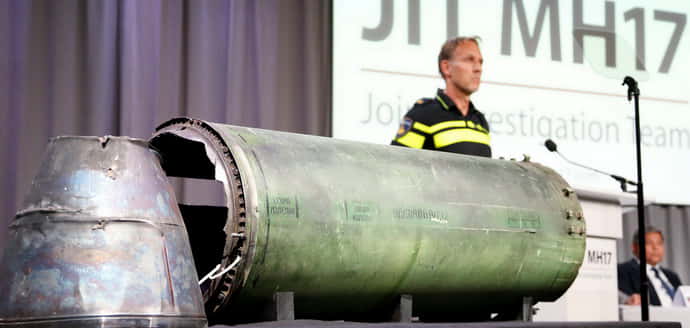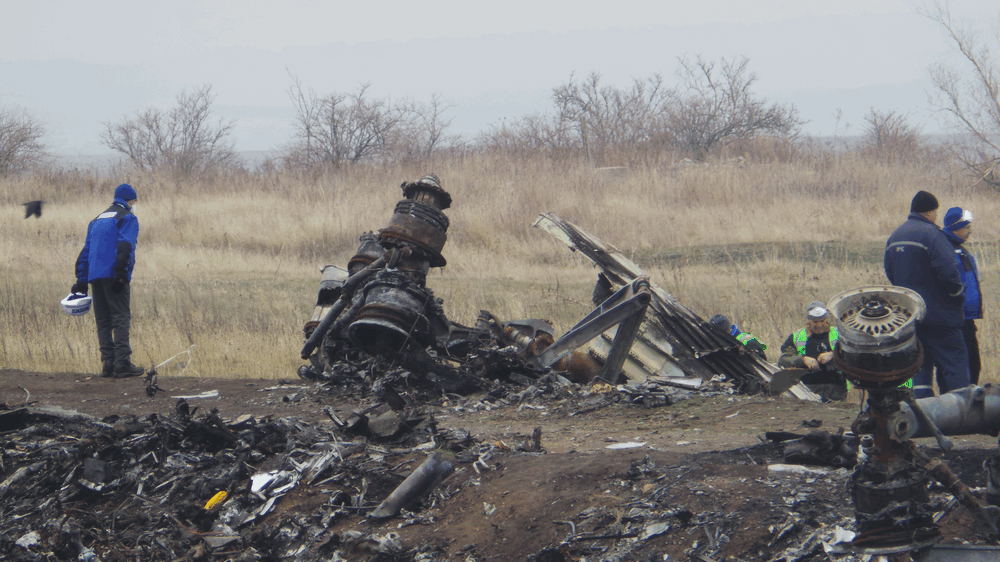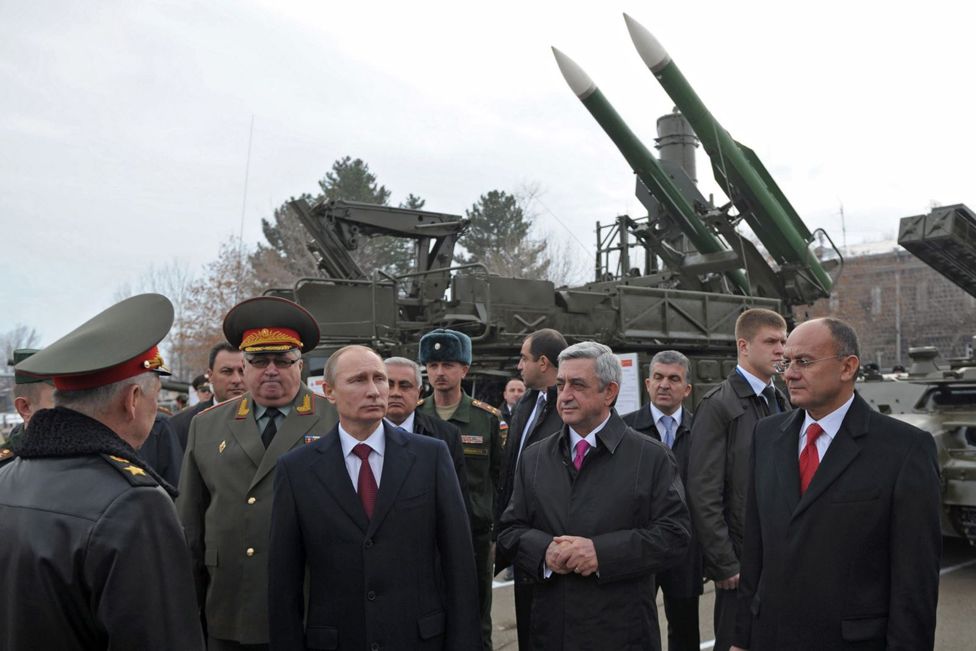Several controlled missile explosions from the Buk rocket launcher were carried out both in Ukraine and abroad. Numerous examinations and many thousands of researched photo and video evidence. Dozens of interrogated witnesses from occupied Eastern Ukraine. Fake documents provided by Russia.
All this was shown in the presentation of the Dutch prosecutor’s office at the trial on the MH17 crash.
This is only a part of the evidence that the investigative team gathered. At the present stage of the Hague District Court’s consideration of the case, the prosecutors’ aim was only to show that the investigation was complete and sufficient for a substantive hearing. But it is already clear why there are only four defendants in the dock.
At least, so far. The Dutch prosecutor’s office proved that it has set a high bar and is building a position as if its opponents are not Girkin and the other defendants, but the entire government of the Russian Federation.
No immunity
We have written about how Russia is defending itself in the MH17 trial.
The lawyers for one of the accused, Lieutenant Colonel of the Russian Airborne Forces Oleg Pulatov, have made great efforts to delay the process.
It was clear from the course of events that they would try to prove that their client had taken part in military action and was therefore immune from ordinary criminal prosecution. Thus, the prosecutor’s office of the Netherlands tried to counterattack in advance, setting out its version.
So what happened in Ukraine in the summer of 2014, according to the investigation?
The prosecution believes that at the time of the MH17 disaster, a military zone existed in eastern Ukraine, within which there was an armed conflict between the Ukrainian government and armed groups that declared independence from Ukraine and the goal of joining the Russian Federation. It is noted that the Russian Federation has played and continues to play an important role in the events in this region, Donbas.
The Ukrainian government launched an anti-terrorist operation to disarm these combatants and liberate the territories.
Let’s recall that charges have been filed in The Hague against four people: Igor Girkin (who called himself “Minister of Defense” and “Commander-in-Chief of the DNR”), his deputy Sergey Dubinskiy (in telephone conversations he was also called “Colonel Petrovsky” or nicknamed “Khmuryi”), the chief of the intelligence unit of the “Donetsk People’s Republic (DNR)” Leonid Kharchenko, and a militant, former Russian lieutenant colonel Oleg Pulatov.

But can they have immunity?
To gain immunity from the usual criminal prosecution, the defense will have to meet difficult requirements.
The so-called “DNR” is definitely not the case.
The prosecutor’s office stressed that the “people’s republics” are not recognized by the international community and cannot have legitimate armed forces.
So maybe they were combatants from the Russian side?
The accused, first of all Girkin, deny it. They say they did not receive orders from anyone from the Russian Federation and were not active in the Russian military at the time. Russia also denies this, as well as the existence of an international military conflict in eastern Ukraine (for example, the case contains materials from the European Court of Human Rights, where Russia has already submitted its position).
Moreover, the Russian Federation offered to independently conduct a usual criminal prosecution of the three accused who are its citizens; that is, even [highlight]the Russian Federation does not officially consider them to have immunity.[/highlight]
The prosecutors’ lengthy speculation suggested why the investigation singled out these four defendants. The others involved in the downing of the airliner (the Russian military, the crew of “Buk” and the chain of command of the Russian Federation) can theoretically claim a different status and legal regime of persecution.
A receipt for a snatched business

The investigation initially proceeded from the fact that the airliner was indeed shot down from a Russian Buk launched from militant-controlled territory.
According to the prosecutor’s office, the Joint Investigation Team (JIT) analyzed all possible versions. In particular, the probability of the following scenarios was studied:
- an explosion inside the plane;
- that it was shot from a military jet;
- that it was shot by another missile, not the Buk system;
- that it was shot down by a Buk missile from Ukrainian-controlled territory;
- that it was shot down from other “DNR”-controlled territory (not the Pervomaiske village).
During the investigation of the aviation accident, the Dutch Security Council even analyzed options that the plane crashed due to an accident – a lightning strike or a collision with a meteorite.
But in the end, the investigation rejected all versions except one – the main one.
In 2018, JIT announced that the Buk came from the 53rd Russian Anti-Aircraft Missile Brigade based in Kursk. As of now, the Dutch prosecutor’s office has not received an answer from the Russian Federation to the question of the whereabouts of this brigade’s Buk with the number 3*2 (the central number is unknown) during 23 June to 23 July 2014.
The investigators established its clear route through numerous photos and videos, studying intercepted talks, comments from social networks, attaching telecommunications data, and witness statements.
There are several phones that moved synchronously on the same route.
The investigation has at its disposal the time of conversations, the names of those who used these phones, their movements, but this will be shown in more detail when the case is heard on the merits.

Here is a route map with telephone providers, photo and video evidence, and testimonials.
The numbers encrypt the witnesses who agreed to cooperate with the Netherlands, and the location of the Buk which describes their testimony. Some of these witnesses are anonymous.
The investigation also analyzed 2481 photos.
15 distinctive signs were found in the Buk – damage, markings, scratches, unique deformations, etc. Photos were compared based on these signs.

The truck which transported the Buk had a telephone number on it. It turned out to be the number of the company “Budmekhanizatsiya” from Donetsk.
The owner of this company was questioned as a witness in August 2014, and he claimed that his business had been seized. This witness showed a document from the militant with the call sign “Batia” as confirmation that the company was snatched.
JIT investigators identified “Batia” and his phone number. The prosecutor noted that the position of this “gentleman in the ‘DNR’ is the deputy commander for support and logistics.” He also testified and is an important witness in the case.
The route of the Buk back to Russia was similarly established. There are fewer photos and videos here, because this time they traveled in the evening and at night. However, there is a witness – a “DNR” militant who handed over the phone numbers of his colleagues and other information to the investigation. There is a video showing the Buk minus one rocket. The Minister of Defense of the Russian Federation said that the video was forged, but as it turned out at the hearings, the SBU was able to seize the camera with which the video was shot and hand it over to The Netherlands.
Together with other evidence, the authenticity of this video was confirmed.
The launch and explosion
The investigation believes that it has definitely established the place of the rocket launch.
It is proved not only by numerous photos after the launch, which shows the smoke and trajectory of the rocket. JIT also has witness testimonies, the result of the examination, and satellite images, including those provided by US intelligence.
Due to the nature of the damage and the direction of the explosion, the Dutch National Aerospace Laboratory (NLR) and the Belgian Royal Military Academy (RMA) determined that the rocket could only be launched from the area around Snizhne. And the field near Pervomaiske is located in the area where the probable launch zones intersect, according to the results of NLR and RMA examinations.
Reconstruction and analysis showed that the damage was concentrated in the left front part of the cockpit – hundreds of large and small holes from the outside to the inside of the aircraft.
The fuel for the rocket was burned in Shostka and the combustion products and soil were collected for a comparative examination.
And, most importantly, two test explosions were conducted here: the explosion of a warhead and the whole missile of a “Buk” (because the plane wreckage contained not only warhead elements).
As a result, holes were obtained on samples of aluminum plates, similar to those found on the wreckage of the Malaysian Boeing.

Paint was also found on the wreckage of foreign elements, which was compared with reference Ukrainian missiles.
JIT conducted experimental explosions of the Buk rocket not only in Ukraine but also in Finland.
In the end, these explosions proved that the airliner was not shot down by a Ukrainian missile.
Particular attention was paid to metal particles – the so-called “butterflies”, which are only contained in the new Russian warhead 9H314M – and which were found among the wreckage of the airliner.

Only two such “butterflies” were found, but experts believe that other particles from the warhead cannot weigh more than 2.5 grams, i.e. all those that weigh more are those very “butterflies” that changed shape after the explosion. 16 of them were found (and even more, if you include fragments weighing 2.1 grams).
These small fragments proved to be very important evidence. They further prove that the plane was shot down by a Buk with a new type of warhead. All Ukrainian missiles and warheads of this type were found on the spot – none of them had been used.
Why did they shoot down MH17?
The prosecutors also tried to uncover the possible reasons for MH17 being shot down. The investigators studied all the available clues, but have so far not arrived at any unambiguous conclusions.
Several circumstances indicate that the crew and militants intended to shoot down a military plane – for example, a recording of a famous conversation between Stelmakh and Bezler about the approaching “bird.”
https://www.youtube.com/watch?v=BbyZYgSXdyw
It turned out that very little time had passed between this conversation and the moment MH17 was shot down.
The version that they wanted to shoot down an Aeroflot plane and blame Ukraine was also considered. But this version is not confirmed.
According to the articles of the Dutch Criminal Code, according to which the accused are tried, it does not matter which plane was shot down, a civilian or military one. Even if the plane is shot down by mistake, the culprits still carry responsibility for shooting down the plane and killing people onboard.
The prosecutor’s office even claims that these articles do not need to prove the intent to kill.
Collection of Russian fakes
The Russian Federation provided Girkin’s written testimony, in which he claims that he did not write the well-known post on his VKontakte account in which he reported about the plane shot down by the militants.

These testimonies are in the case, as well as data on how the separatists were first ecstatic from downing an alleged Ukrainian military plane, then changed their posts on social networks, then began to declare that the “DNR” does not have any Buks and so on.
Radar recordings, including data from Ust-Donetsk provided by the Russian Federation, did not show the presence of another aircraft near MH17. No Ukrainian military aircraft was in the conflict zone that day.
By the way, experts say that there is only one type of air-to-air missile that could cause damage similar to that found on some wreckage of the MH17 – but they are used only by the MiG-31, which is in service only in Russia.

Rhotos of radar data which were shown on the state TV channel of the Russian Federation, showing MH17 shooting down another plane, are obviously faked.
JIT analyzed and ruled out all other types of weapons in Ukraine and Russia, which are at least theoretically capable of shooting down an aircraft at an altitude of 10 km.

All of them were compared with the photo of the Buk, for which the route and launch location were established. All of them could have shot down MH17.
Curiously, Ukraine did not initially report one Buk (apparently, it did not believe that it was in the questioned range), but the military intelligence of the Netherlands learned about it and also included it in the inspection.
There was a Buk remaining in occupied Donetsk, but there is photo evidence that it was broken and not used (it even has rusty wheels).
[highlight]Importantly, Russia deliberately tried to give the investigation forged documents.[/highlight]Particularly, JIT has previously released the serial number of the missile that shot down the liner. In response, the Russian side said that this missile was once handed over to Ukraine, and copies of documents about this transfer were provided in Moscow.
But Moscow miscalculated, because they did not know that JIT found a fragment of the rocket with the assembly date among the wreckage of the plane: 15.12.1986.
However, Russia “drew” documents alleging it handed a missile with this serial number, but with a different assembly date, to Ukraine.

The documents Russia provided, in addition to being manipulative, do not prove that the missile was in Ukraine’s possession at the time of the downing. And Russia did not specify where this rocket actually was.
Overall, the evidence presented by the Dutch prosecutor’s office appears quite convincing and reveals the depth of the JIT investigation which had been ongoing for all these years.
 Andriy Guck is a lawyer, aviation law expert, and a partner in the legal company Ante.
Andriy Guck is a lawyer, aviation law expert, and a partner in the legal company Ante.
Read also:
- Ukraine holds man who transported missile launcher which shot down MH17
- Intercepted phone calls show MH17 suspects’ connections to Russian military and Kremlin
- Bellingcat IDs GRU agent for occupied Donetsk and possible MH17 witness
- The most comprehensive guide ever to MH17 conspiracies








